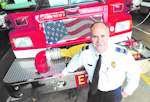Since Sept. 11, 2001, much work has been done in the pursuit of interoperable public safety communications. In 2002, the U.S. Department of Homeland Security’s (DHS) Office of Interoperability and Compatibility (OIC) published the SAFECOM Interoperability Continuum; a document that defined the fundamental elements required to achieve public safety interoperable communications; governance, standard operating procedures, technology (voice/data), training/exercises and usage.
With an eye on achieving interoperable public safety communications, the Virginia State Police (VSP) initiated a program that would leverage the Statewide Agency Radio (VHF high-band digital land mobile radio) System (STARS) by linking to local public safety radio systems via a “patch” between the VSP and the localities’ land mobile radio (LMR) systems. This patch can be achieved not only between the VSP and the locality, but also locality to locality.
This system of systems would create a Voice over Internet Protocol (VoIP) capability, also known as Radio over IP (RoIP), and essentially enable every agency to expand its radio communications capability to anywhere that Internet connectivity is available. This evolved into what would later be called the Commonwealth’s Link to Interoperable Communications (COMLINC). COMLINC involves 20-plus participating state agencies and the RIOS Wide-Area Network interconnects Public Safety Answering Points (PSAPs), Virginia State Police Divisional and State Headquarters, Virginia Department of Emergency Management, Virginia Army National Guard, Hospitals, Universities and mobile communications systems located throughout Virginia (172 operational by July 2010). One of the largest interoperability networks of its kind, RIOS COMLINC provides advanced interoperability, monitoring, recording, and alerting to counties, cities, and towns comprising over 30,000 square miles. The RIOS interfaces to existing equipment; Motorola (VHF, UHF, 800 MHz Digital Trunk), MA/COM (800 MHz Digital Trunk), Kenwood (UHF) and Nextel iDEN.
There are three staged radio caches in Virginia. Each radio cache also incorporates a portable RIOS that allows for mobile and remote interoperability and connectivity back to COMLINC.
RIOS technology
RIOS, the technology that allows the IP connectivity and “patching” capability, is formally known as the Radio Interoperability Operating System. Designed by Sytech Corp., RIOS is a gateway that connects disparate LMR systems, enabling multiple agencies to communicate.
This technology does more than just enable interoperable voice communications; it also allows sharing of files, data and video. The one limitation is that such a patching requires a dedicated channel or talk group from each of the disparate radio systems to achieve the interoperability. However, during this time of budget constraints, the ability to leverage and link the present radio systems may be the only way that some of the agencies involved would ever have the opportunity to be interoperable. The RIOS also has a very intuitive graphical user interface and it is easy to use.
Sytech has now developed a smartphone app (RIOS Lite) that virtually turns a smartphone into a mobile device that can interface and communicate with the local LMR system and with other RIOS Lite users. Additionally, this app also enables the transfer/sharing of files, data and real-time video over commercial wireless networks. The smartphone app will soon be available to present RIOS users and will work on Android smartphones and Apple iPhones. This is about as close to “24”-like technology as it gets.
Governance
The COMLINC operation is accomplished through collaboration between the VSP and the commonwealth’s Interoperability Communications Office (CICO). The governance of Virginia’s interoperability efforts are guided by the Statewide Interoperability Executive Committee (SIEC), which is comprised of public safety practitioners from across Virginia. The first commonwealth interoperability coordinator was Chris Essid, who now serves as the deputy director of the DHS Office of Emergency Communications. An additional aspect of statewide planning guidance was through implementation of Statewide Communications Interoperability Plans (SCIPs). More recently, the commonwealth interoperability coordinator position was held by Chris McIntosh, who worked to help further expand the COMLINC program.
COMLINC’s value comes in the ability to create interoperable communications for daily operational needs, during planned special events and during emergency incidents. In Charlottesville and other localities, it has been invaluable during planned events to link regional agencies to VSP and other federal agencies.
Precursor to FirstNet
The First Responders Network Authority (FirstNet) is responsible for developing the first nationwide public safety broadband wireless network, which will enable similar interoperability and public safety communications concepts such as COMLINC.
The importance of COMLINC is that it is demonstrating how similar projects presently working over commercial wireless networks and the potential of what the FirstNet broadband network will be to public safety and all of its mission-critical partners.

Charles Werner
CHARLES WERNER, who is a Firehouse contributing editor, is a 45-year veteran of public safety. He served with the Charlottesville, VA, Fire Department for 37 years, serving the past 10 years as chief. Following retirement, Werner served for two years as senior adviser and acting deputy state coordinator for the Virginia Department of Emergency Management. He has chaired: DHS SAFECOM Executive Committee; IAFC Technology Council; National Information Sharing Consortium; and DHS/White House Incident Management Information Sharing SubCommittee. Werner currently serves as the director of DroneResponders Public Safety Alliance, chair of the National Council on Public Safety UAS and chair of the Virginia Secure Commonwealth UAS Sub Panel.






